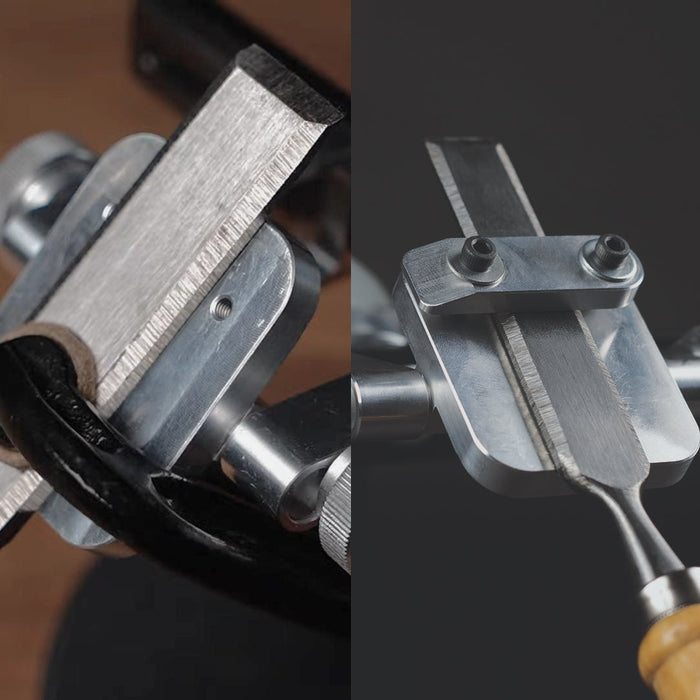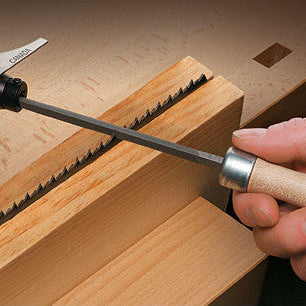
Tool Sharpening
Sharpening of Cutting Tools The use of any cutting tool inevitably leads to wear and a reduction in the sharpness of the cutting edge. The cutting edge is the working part of the tool, formed by the convergence of two...

Hunting and pocket knife lovers, as well as professional chefs, know that the best way to sharpen a blade is with a sharpening stone. But not everyone has a clear understanding of what this tool is, how to choose it from the available options, what is the difference between "synthetic" and "natural" abrasive materials.
It is a rectangular abrasive element that can be used to sharpen a knife, repair edge defects and restore the blade angle provided by the manufacturer.
Sharpening stones have been used since the invention of the metal knife. They are now a must-have accessory for all admirers of edged weapons as well as a quality kitchen knife. They are also used by chefs or home cooks who love sharp knives and devote much time to caring for them.
The sharpening stones available in stores are divided into two types based on material - natural and synthetic. They have their own features, advantages and disadvantages. Before you buy a sharpening stone, it is best to look into its specifications in detail.

They are made of high-strength rocks. Any minerals with a fine grit structure with abrasive properties are suitable. The most popular stones among knife lovers come from Japan, USA, Belgium, Germany and Turkey.
You should be very careful when purchasing natural sharpening stones. Manufacturers offer high quality minerals and low quality stones. This scatter in specifications is due to two reasons:
Despite certain drawbacks, natural rock sharpening stones remain popular among knife lovers. The key is to get the best option in its range.

There is no universal advice on which sharpening stone to choose. Both synthetic and natural stones can make a knife razor sharp. The end result depends on what steel the blade is made of, what abrasive material is used for making the sharpening stone, and how skilled you are at using these tools.
Arkansas sharpening stones, which are mined and made in the United States, are especially appreciated. It is a natural stone made of quartz, with a purity of almost 100% and an abrasiveness of 1-6 microns.
Japanese stones are also popular. They were used to sharpen the blades of traditional katana swords several hundred years ago.
The main problem with natural bars is that the raw materials used to produce them are not a renewable source. Because of this, the stone extraction from some deposits is now strictly regulated and limited in various countries around the world. This creates shortages of products, which drives up prices in the market.
Best quality natural whetstones are now only used by professionals with extreme care.
This term is a name for stones made of abrasive materials. It is due to the way these sharpening whetstones are used — they are used with water. All whetstones are divided into three types according to the way of use:
That is, "water" refers to abrasive whetstones that require water for use. Water helps to form a protective layer on the surface and also prevents the clogging of surface. The sharpening stone will wear less and retain its properties longer with the use of the cooling liquid (water or something else).
The sharpening stone itself consists of two elements:
After being moistened with water, as the blade moves back and forth, the abrasive particles slowly break away from the matrix, mix with the liquid, and form the working layer. It works on the edge and gradually removes material from it, forming a sharp blade at the desired angle.
Before use, soak the stone in water until it stops releasing air bubbles. Depending on the porosity and grit, this takes up to half an hour. And add water to the surface if it dries out.

The scarcity of natural whetstones and the high cost of such a sharpening whetstone forced manufacturers to look for an alternative solution. Especially since the stock of quartz rock for their production is limited, sooner or later they will become exhausted.
As a substitute, companies that make knives and sharpening equipment came up with synthetic sharpening whetstones. Most often, they are made of:
During the manufacturing process, the manufacturer can choose the grit size, control the uniformity of the mixture, choose hardness and type of the binding agent. This has brought a wide range of sharpening stones to the market for different blade types and finishing quality grades.
Nowadays the buyer can choose a relatively inexpensive sharpening stone with the desired grit, which will last much longer than a natural stone thanks to a high-quality binding agent.

The special feature of diamond knife sharpening stones is high efficiency and easy maintenance. You do not have to use water with diamond stones to prevent wear or follow other rules of use. It is enough to spray the surface for the best blade sliding.
The drawback of these stones is the aggressive impact of diamond grits on the blade. Diamond coating has a high hardness, so it removes too much metal from the edge. You need to use it carefully.
Most often people use diamond stones for coarse straightening (honing) of edges, for coarse sharpening stages and removing serious damage. After that, they sharpen the knife with finer and softer non diamond whetstones.

Ceramic abrasives are the most modern and convenient among all the available stones. They use solid ceramic particles to make the whetstones. They are close to natural quartz in their properties and to diamond in their strength. The buyer gets a tool similar in characteristics to a natural stone, but at a lower price and with a longer service life.
A ceramic surface allows you to sharpen your knife with high quality. But the process will take a long time. Usually they are used for final polishing of the edge and to make it razor sharp.
It is not necessary to moisten the abrasive surface during work. It is enough to rinse off the metal residue after you finish the process.
Due to the simplicity of production, manufacturers make ceramic bars of different shapes, so they can be used to restore the sharpness of various items - scissors, needles, hooks and knives.
The most important characteristic of a sharpening stone, regardless of its material, is its grit. It is indicated by the numbers in the label next to the word grit. The quality of the blade finish depends on it.
Manufacturers offer whetstones with grit ratings from 80 to 10000 grit. They use them for different types of work:
Do note that stores also sell combined synthetic stones. They look like a double-layer stone with each side having a different grit. Each surface is labeled with a marking. Such a purchase allows you to save money, but during work you need to keep a whetstone clean and avoid contaminating the opposite side.
Sharpening usually involves side by side treatment of the blade edge on abrasive surfaces with different grit starting from 200 or 400 (depending on the damage). And the grit value of each next one should be about 2 times larger than the previous one. For example, 400, 1000, 3000, 6000.
When shopping, you need to consider the size of the stone. The wider and longer the stone, the larger knives you can sharpen with this stone. This will also make it easier to maintain the necessary sharpening angle. The thickness only determines the service life. The larger it is, the longer it will wear out.
Abrasive whetstones are one of the most effective but difficult to use sharpening tools. When using them, it is best to follow a few rules:
Follow this guide to choose the best whetstone for yourself.
However, if manual knife sharpening with a whetstone seems too difficult for you, you can use special equipment. For example, a sharpening system with a guide rod from TSPROF. They are sold as kits with different types of stones - usually diamond coated stones. Their best advantage is the ability to securely clamp knives and sharpen the edge at the required angle.

Sharpening of Cutting Tools The use of any cutting tool inevitably leads to wear and a reduction in the sharpness of the cutting edge. The cutting edge is the working part of the tool, formed by the convergence of two...

Slip stones are special sharpening stones designed for sharpening special cutting tools, such as woodworking equipment. They come in various shapes and sizes. Learn more about their types and purposes in this article.

A file or a special abrasive? In the world of sharpening, the word "file" might sound a bit out of place, especially for those not too familiar with hand tools. Most people would associate it with a rough metalworking tool,...
{"one"=>"Select 2 or 3 items to compare", "other"=>"{{ count }} of 3 items selected"}